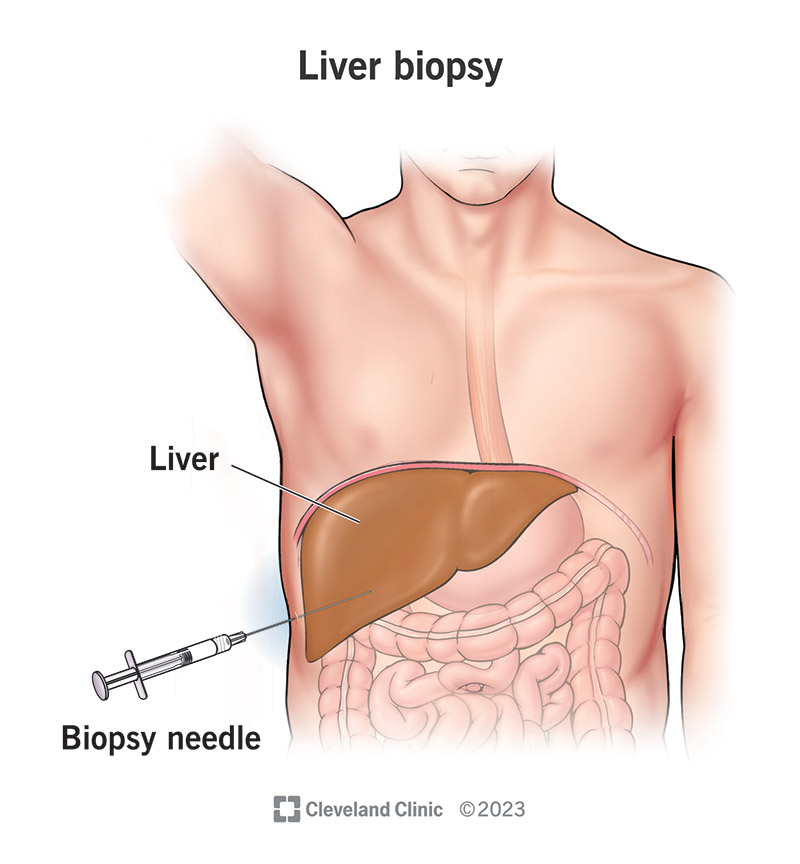A liver biopsy is a simple bedside procedure. A healthcare provider uses a hollow needle to draw a tiny tissue sample from your liver. A pathologist will study it under a microscope. This sample can reveal crucial information about your liver condition.
Advertisement
Cleveland Clinic is a non-profit academic medical center. Advertising on our site helps support our mission. We do not endorse non-Cleveland Clinic products or services. Policy

A liver biopsy is a minor procedure to take a tiny tissue sample from your liver through a hollow needle. Healthcare providers do this in a few different ways, depending on your condition. After the procedure, a pathologist analyzes the tissue sample in a lab to help diagnose and stage various liver diseases.
Advertisement
Cleveland Clinic is a non-profit academic medical center. Advertising on our site helps support our mission. We do not endorse non-Cleveland Clinic products or services. Policy
Reasons for a liver biopsy include:
A liver biopsy can diagnose certain general liver conditions, such as:
It also can isolate specific causes or types of liver disease, such as:
There are three types of liver biopsy procedures. Each one is done a little differently.
Advertisement
The most common type of liver biopsy is a percutaneous liver biopsy. “Percutaneous” means “through the skin.” This means that a healthcare provider inserts the biopsy needle directly through the skin of your abdomen and into your liver. This is the least invasive method, which is why it’s often a first choice.
You might have a transvenous liver biopsy instead if you have a bleeding disorder or too much fluid in your abdomen. “Transvenous” means “through a vein.” In this procedure, the biopsy needle passes through a tiny catheter in your jugular vein to reach your liver. It’s also called a transjugular liver biopsy.
Sometimes you might have a liver biopsy during abdominal surgery that you’re having for another purpose. This can happen during open abdominal surgery or laparoscopic surgery. Surgeons perform laparoscopic surgery through small “keyhole” incisions with the aid of a tiny camera (laparoscope).
Unless you’re having surgery, you probably won’t have general anesthesia for a liver biopsy. Healthcare providers prefer you to be conscious for the procedure so that you can participate, if needed. For example, they might ask you to hold your breath briefly. But you can have sedation if you wish.
Preparation for a liver biopsy procedure includes:
The procedure itself takes about 15 to 30 minutes for a percutaneous biopsy or 30 to 60 minutes for a transvenous biopsy. But you’ll be in the hospital for several hours after that, under observation.
Advertisement
Prior to the procedure, you may have:
During the biopsy procedure:
Advertisement
The most pain you’ll feel during the procedure is from the injection of local anesthetic in your skin. This will numb the area for the biopsy needle, but it does sting for a minute before it starts working. After that, the biopsy itself shouldn’t be painful, though you might feel deep pressure or vague discomfort.
You’ll rest quietly in a recovery room for the next two to four hours. Your healthcare team will continue to monitor your vital signs and watch for any emerging complications. Most complications that do emerge will do so in this time frame. They’ll also ask if you have any pain and treat it if necessary.
A liver biopsy is a common and generally safe procedure when an experienced healthcare provider performs it. Serious complications are rare. The most common complications after the procedure are temporary pain and low blood pressure. The risk of life-threatening complications is estimated at 0.1%.
Common complications include:
Advertisement
Rare but serious complications include:
You’ll want to take it easy for about a week. Avoid rigorous exercise or lifting more than 10 to 15 pounds. The only aftercare is keeping your incision site clean while it heals. It may leave a tiny scar. Consult your provider about resuming your regular medications and treating any residual pain.
After your procedure, your liver tissue sample will go to a lab, where a pathologist will study it under a microscope. They’ll write a report explaining what they find. They’ll send this back to the healthcare provider who ordered it, and they’ll discuss the results with you. This might take a few days to a week.
Contact your healthcare provider if you develop:
For most people, a liver biopsy is a brief and tolerable procedure. It’s a little more involved if it’s done through a vein, but the few additional steps are worthwhile to make the procedure safe for you. This test can give your healthcare provider crucial information about your condition and how to treat you.
Cleveland Clinic providers compassionately diagnose and treat all liver diseases using advanced therapies backed by the latest research.

Last reviewed on 09/19/2023.
Learn more about the Health Library and our editorial process.